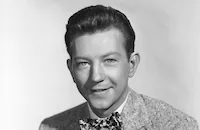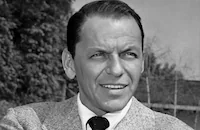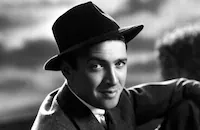That's Entertainment!

Brief Synopsis
Cast & Crew
Jack Haley Jr.
Fred Astaire
Gene Kelly
Elizabeth Taylor
Donald O'connor
Mickey Rooney
Film Details
Technical Specs
Synopsis
MGM musicals are celebrated in this anthology. It is presented in segments introduced by stars on the MGM backlot, including Frank Sinatra, Gene Kelly, Fred Astaire, Peter Lawford, Donald O'Connor, Debbie Reynolds, Mickey Rooney, Bing Crosby, James Stewart, Elizabeth Taylor, and Liza Minnelli who represents her late mother, Judy Garland. The film also features archival footage of legendary MGM stars and rarely seen performances such as a singing and dancing Clark Gable.
Director
Jack Haley Jr.
Cast

Fred Astaire

Gene Kelly

Elizabeth Taylor

Donald O'connor

Mickey Rooney

Frank Sinatra

Bing Crosby

Debbie Reynolds

Liza Minnelli

James Stewart

Peter Lawford
Crew
Claude Binyon Jr.
David Blewitt
Richard Bremerkamp
Lyle Burbridge
John Dunning
Mort Feinstein
Arthur Freed
Bud Friedgen
Allan Green
Ennio Guarnieri
Jack Haley Jr.
Jack Haley Jr.
Robert R. Hoag
Jesse Kaye
Ernest Laszlo
Jim Liles
Henry Mancini
William Mccaughey
Daniel Melnick
Russell Metty
Gene Polito
Aaron Rochin
Dave Silver
Harry W. Tetrick
Hal Watkins
Videos
Movie Clip




Trailer
Hosted Intro




Film Details
Technical Specs
Articles
That's Entertainment!
MGM had fallen on hard times by 1974. The once glorious studio only released five films that year. But new president Frank E. Rosenfelt heralded the studio's golden anniversary by announcing that "the roar of Leo the Lion will not be reduced to a weak meow." With That's Entertainment!, he proved that Leo's roar was far from forgotten, either.
The film was supervised by studio production chief Daniel Melnick, but the familiar name all over the credits - as producer, director and writer - was the studio's head of creative affairs, Jack Haley, Jr., son of the vaudeville star who achieved immortality as the Tin Woodsman in The Wizard of Oz (1939). Haley and his crew spent 19 months pouring through the studio's archives to find clips from more than 200 features and shorts that captured the feel of MGM and its musicals. Editors Bud Friedgen and David Blewitt cut together highlights from 84 different musical numbers, shortening some numbers seamlessly and cutting them all together with a fluidity that kept the 127-minute film moving at a rapid pace.
To introduce the clips, Haley assembled an all-star cast including former MGM contract players like Frank Sinatra and Elizabeth Taylor and performers like Donald O'Connor (Singin' in the Rain, 1952) and Bing Crosby (High Society, 1956) who had scored career triumphs at MGM. The one youngster in the cast was Liza Minnelli, but she fit in perfectly as the daughter of the studio's greatest singing star, Judy Garland, and it's most honored musical director, Vincente Minnelli. She even went on to marry Jack Haley, Jr., the same year That's Entertainment! was released. (The marriage ended in 1979.)
To give the film some unity, Haley grouped the clips by theme. James Stewart, a non-singer who had introduced the Cole Porter classic "Easy to Love" in the 1936 Born to Dance, presented musical clips featuring non-musical performers like Clark Gable and Cary Grant. Gene Kelly paid tribute to fellow hoofer Fred Astaire, who returned the favor in a later segment. Minnelli introduced clips from her mother's films, including her own film debut as Garland's daughter in the final shot of In the Good Old Summertime (1949). And in one of the film's lightest segments, O'Connor presented a series of ever more grandiose water ballets featuring Hollywood's only swimming musical star, Esther Williams. There were also inspired excerpts from signature MGM numbers which have become classics - the barn-raising scene in Seven Brides for Seven Brothers (1954), Fred Astaire dancing on the ceiling in Royal Wedding (1951), Donald O'Connor performing "Make 'Em Laugh" in Singin' in the Rain and Gene Kelly's dancing duet with Jerry the Mouse in Anchors Aweigh (1945).
Most of the host segments were filmed on various locations around the MGM lot: the small-town street where the Andy Hardy films and Meet Me in St. Louis (1944) were shot; the railway station where Astaire sang his first number in The Band Wagon (1953); even the filled-in swimming pool where most of Williams' extravaganzas had been shot.
Many critics and audience members were wildly enthusiastic about the opportunity to re-visit the greatest moments from MGM's musical past. There were a few complaints, however, about the necessity to cut musical numbers to fit more material into the film's running time. There was also a minor fracas when MGM's favorite tap-dancing lady, Ann Miller, was hired to make personal appearances for the film. Some of the studio's other stars objected to the fact that she was the only one getting a paycheck while their past performances generated new revenues for the studio. But on the whole, That's Entertainment! was a triumph. It landed on the year's box-office top 20 alongside such contemporary fare as The Sting (1973) and The Towering Inferno (1974), showing that audiences still had a taste for the kind of old-fashioned entertainment that had once made the studio great. Blewitt and Friedgen captured the American Cinema Editors' Eddie Award for Best Edited Documentary. And most significantly, the film triggered renewed interest in MGM's musicals, which the studio wisely presented in new television syndication packages and theatrical reissues designed to draw on the success of its biggest hit in years.
Producer: Jack Haley, Jr., Daniel Melnick
Director: Jack Haley, Jr.
Screenplay: Jack Haley, Jr.
Cinematography: Gene Polito, Ernest Laszlo, Russell Metty, Ennio Guarnieri & Allan Green
Music: Henry Mancini
Narrators: Fred Astaire, Bing Crosby, Gene Kelly, Peter Lawford, Liza Minnelli, Donald O'Connor, Debbie Reynolds, Mickey Rooney, Frank Sinatra, James Stewart, Elizabeth Taylor.
BW & C-135m. Closed captioning. Letterboxed.
by Frank Miller

That's Entertainment!
That's Entertainment: The Ultimate Anthology of M-G-M Musicals - THAT'S ENTERTAINMENT! THE ULTIMATE ANTHOLOGY OF M-G-M MUSICALS - New, expanded edition
THAT'S ENTERTAINMENT! THE ULTIMATE ANTHOLOGY OF M-G-M MUSICALS expands the original landmark release with an entire disc of never before released music, and uses new technology to upgrade the sound quality of 30 percent of the original box set. The newly expanded and upgraded version of THAT'S ENTERTAINMENT! is available April 25 at regular retail outlets. To order the That's Entertainment anthology, go to TCM Shopping.
The six-CD collection contains 135 tracks – nearly 8 hours of music – gathered from M-G-M movies released between 1929 and 1957 including unforgettable performances from more than 75 classic musicals including The Wizard Of Oz, Meet Me In St. Louis, Singin' In The Rain, Easter Parade, Kiss Me Kate, Brigadoon, An American In Paris and more.
The performances feature some of the biggest names among Hollywood royalty: a trio of Bing Crosby duets from 1956's High Society featuring Frank Sinatra for "Well Did You Evah?," Louis Armstrong for "Now You Has Jazz," and Grace Kelly for "True Love"; Doris Day sings "Ten Cents A Dance" and "Shakin' The Blues Away"; Elvis Presley leads the prison band through "Jailhouse Rock" and Fred Astaire and Janice Paige perform "Stereophonic Sound" from Silk Stockings.
The collection's sixth disc contains 25 performances that have never been released including demos, outtakes and complete version of songs edited for film. Highlights include: two songs from the uncompleted film, The March of Time, including Bing Crosby singing "Poor Little G-String"; Jimmy Durante and Polly Moran spoofing Rodgers and Hart's "Shuffle Off To Buffalo" with a song called "Fly Away To I-Oway"; "You Belong To My Heart" featuring Yvonne DeCarlo, who later earned fame as television's Lily Munster; a pair of songs performed by Joan Crawford "Follow Me" and "Something's Gotta Happen Soon"; Lena Horne singing "You Won't Forget Me," a song lip-synced by Crawford in Duchess of Idaho; the complete version of "My Man" performed by Fanny Brice - the inspiration for the movie Funny Girl; and "Baby Doll" performed by Gene Kelly for Take Me Out To The Ballgame, a song cut from the movie but sung later by Fred Astaire in Belle Of New York.
That's Entertainment: The Ultimate Anthology of M-G-M Musicals - THAT'S ENTERTAINMENT! THE ULTIMATE ANTHOLOGY OF M-G-M MUSICALS - New, expanded edition
Donald O'Connor, 1925-2003
Born Donald David Dixon O' Connor in Chicago on August 28, 1925, he was raised in an atmosphere of show business. His parents were circus trapeze artists and later vaudeville entertainers, and as soon as young Donald was old enough to walk, he was performing in a variety of dance and stunt routines all across the country. Discovered by a film scout at age 11, he made his film debut with two of his brothers in Melody for Two (1937), and was singled out for a contract by Paramount Pictures. He co-starred with Bing Crosby and Fred MacMurray in Sing, You Sinners (1938) and played juvenile roles in several films, including Huckleberry Finn in Tom Sawyer - Detective (1938) and the title character as a child in Beau Geste (1939).
As O'Connor grew into adolescence, he fared pretty well as a youthful hoofer, dancing up a storm in a string of low-budget, but engaging musicals for Universal Studios (often teamed with the equally vigorous Peggy Ryan) during World War II. Titles like What's Cookin', Get Hep to Love (both 1942), Chip Off the Old Block and Strictly in the Groove (both 1943) made for some fairly innocuous entertainment, but they went a long way in displaying O'Connor's athletic dancing and boyish charm. As an adult, O'Connor struck paydirt again when he starred opposite a talking mule (with a voice supplied by Chill Wills) in the enormously popular Francis (1949). The story about an Army private who discovers that only he can communicate with a talking army mule, proved to be a very profitable hit with kids, and Universal went on to star him in several sequels.
Yet if O'Connor had to stake his claim to cinematic greatness, it would unquestionably be his daringly acrobatic, brazenly funny turn as Cosmo Brown, Gene Kelly's sidekick in the brilliant Singin' in the Rain (1952). Although his self-choreographed routine of "Make "Em Laugh" (which includes a mind-bending series of backflips off the walls) is often singled out as the highlight, in truth, his whole performance is one of the highlights of the film. His deft comic delivery of one-liners, crazy facial expressions (just watch him lampoon the diction teacher in the glorious "Moses Supposes" bit) and exhilarating dance moves (the opening "Fit As a Fiddle" number with Kelly to name just one) throughout the film are just sheer film treats in any critic's book.
After the success of Singin' in the Rain, O'Connor proved that he had enough charisma to command his first starring vehicle, opposite Debbie Reynolds, in the cute musical I Love Melvin (1953). He also found good parts in Call Me Madam (1953), There's No Business Like Show Business (1954), and Anything Goes (1956). Unfortunately, his one attempt at a strong dramatic role, the lead in the weak biopic The Buster Keaton Story (1957) proved to be misstep, and he was panned by the critics.
By the '60s, the popularity of musicals had faded, and O'Connor spent the next several years supporting himself with many dinner theater and nightclub appearances; but just when it looked like we wouldn't see O'Connor's talent shine again on the small or big screen, he found himself in demand at the dawn of the '90s in a string of TV appearances: Murder She Wrote, Tales From the Crypt, Fraser, The Nanny; and movies: Robin Williams' toy-manufacturer father in Toys (1992), a fellow passenger in the Lemmon-Matthau comedy, Out to Sea (1997), that were as welcoming as they were heartening. Survivors include his wife, Gloria; four children, Alicia, Donna, Fred and Kevin; and four grandchildren.
by Michael T. Toole
Donald O'Connor, 1925-2003
Quotes
Trivia
Miscellaneous Notes
Released in United States 1974
Released in USA on video.
Released in United States 1974














